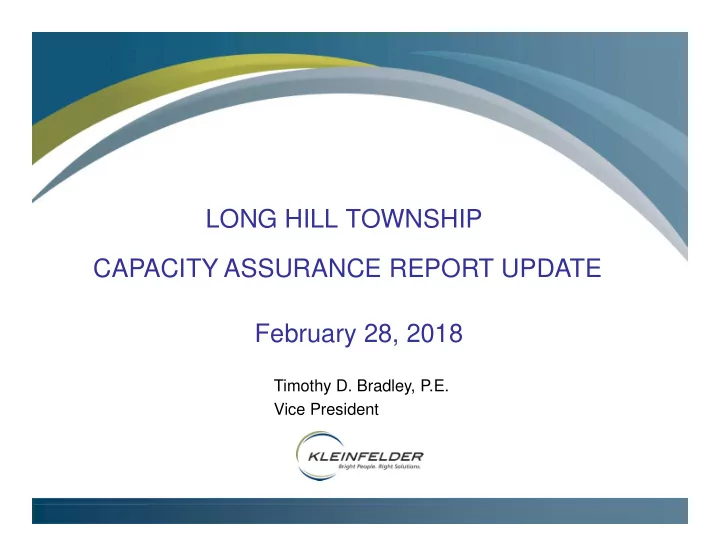

LONG HILL TOWNSHIP CAPACITY ASSURANCE REPORT UPDATE February 28, 2018 Timothy D. Bradley, P.E. Vice President KLEINFELDER CONFIDENTIAL
Presentation Outline Purpose of a Capacity Assurance Report (CAR) Existing Wastewater System Conclusions and Outcome of 2010 CAR Objective of CAR Update Update of Current and Future Flows Update of Improvements and Costs Accommodate future flow Comply with the future effluent limit for total Phosphorus (TP)
Purpose of a CAR Identify what improvements, if any, are required to accommodate anticipated growth within the sewer service area and to ensure reliable permit compliance In so doing, establish a facility plan for addressing future needs and water quality protection NJDEP requires that permittees prepare a CAR when flows approach permitted capacity
Wastewater Treatment Plant (WWTP)
WWTP Originally constructed in 1930s Permitted capacity: 0.9 mgd Actual flow has exceeded permitted capacity for many years Due to groundwater and rainwater entering the wastewater collection system, referred to as infiltration and inflow (I&I)
Wastewater Collection System Components 286,290 feet of LHT-owned sanitary sewers 221,325 feet of privately owned service laterals 1,260 manholes 8 pumping stations 15,200 feet of force mains Age Original portions date to 1930s and 1940s Significant additions in 1970’s As systems age and progressively deteriorate, I&I increases
Conclusions of 2010 CAR Based on a cost comparison of various combinations of plant improvements and sewer system rehabilitation to reduce I&I it is not cost effective to remove I&I to provide sufficient capacity for future growth System Upgrade Alternative Budgetary Capital Cost No I&I Reduction $4,140,000 25% I&I Reduction $8,270,000 50% I&I Reduction $16,760,000 The No I&I reduction alternative was based on construction of a flow equalization tank to temporarily store peak flow during rain events Because I&I will increase over time as the system continues to age and deteriorate, a program of periodic sewer rehabilitation was also recommended Addition of a coagulant storage and feed system recommended to comply with future effluent limit for Total Phosphorus (TP)
Outcome of 2010 CAR Defer implementation of improvements to accommodate future flow Defer implementation of improvements to comply with the future TP limit until specifically required by NJDEP Proceed with a project to: Implement two needed improvements at the WWTP Proceed with the first phase of a sewer rehabilitation program 13,150 feet or 4.6% of system Project cost - $2.6 million
Objectives of CAR Update Update the current wastewater characteristics Update the projected future wastewater characteristics Update the assessment of plant capacity Update the assessment of improvements and costs needed to accommodate future flow Update the assessment of costs to comply with the future effluent limit for TP
Current and Future Flow Update Flow Condition Current Future Annual Average 1.04 mgd 1.24 mgd Maximum Monthly Average 1.8 mgd 2.27 mgd Maximum Daily Average 3.47 mgd 4.14 mgd Peak Hourly 4.4 mgd 5.2 mgd Future annual average flow consistent with the Interim Draft Morris County Wastewater Management Plan (WMP) No measureable decrease in I&I before and after rehabilitating 4.6% of the wastewater collection system I&I reduction in the 4.6% of the system that was rehabilitated was offset by I&I creep in the 95.4% of the system not rehabilitated
Update of Capacity Improvements for Future Flow Two alternatives Identified Alternative Budgetary Capital Cost Flow Equalization $4.4 million Plant Expansion $2.8 million Key component of the Flow Equalization Alternative is a new 1.6 million gallon storage tank Key component of the Plant Expansion Alternative is replacement of the existing effluent filters with a newer filter technology that is more compact and efficient than the existing sand filters To prevent future increases in I&I that would exceed the capacity of the identified alternatives, a program of periodic sewer rehabilitation is also recommended to compensate for ongoing collection system deterioration as the system continues to age
Update of Improvements for Future TP limit Only one viable alternative – addition of a coagulant storage and feed system to enable the chemical precipitation of phosphorus Updated budgetary capital cost – 0.8 million Annual chemical cost – conservatively $146,000/year Site-specific testing required to confirm optimal coagulant, coagulant dose and corresponding cost New TP effluent limit will be incorporated into the renewed NJPDEP discharge permit which NJDEP is currently drafting
Summary of Needs and Budgetary Costs Improvement Budgetary Capital Cost Plant Expansion for Future Flow $2.8 million Compliance with new TP Limit $0.8 million Total $3.6 million Total implementation time for design, permitting, bidding and construction – 30 months Low interest financing available through the New Jersey Environmental Infrastructure Financing Program Budgetary capital cost does not include periodic sewer rehabilitation
Discussion / Questions Questions
Recommend
More recommend